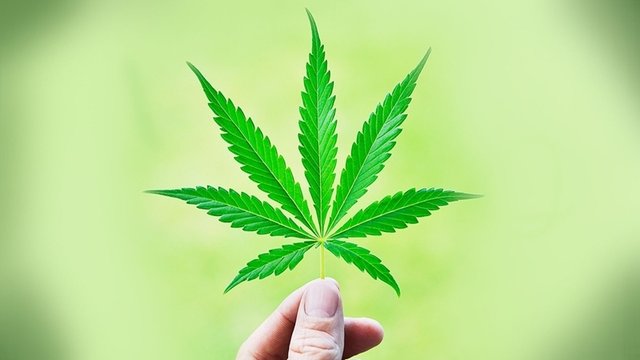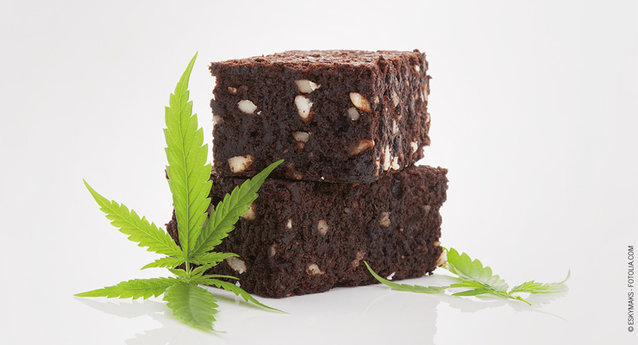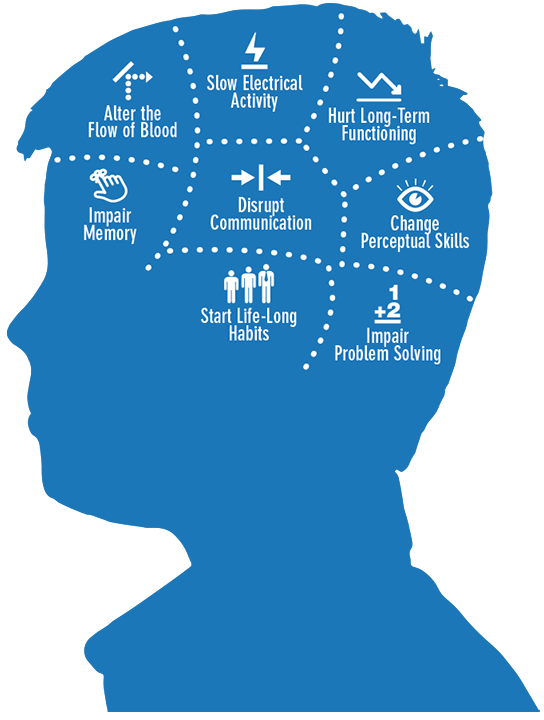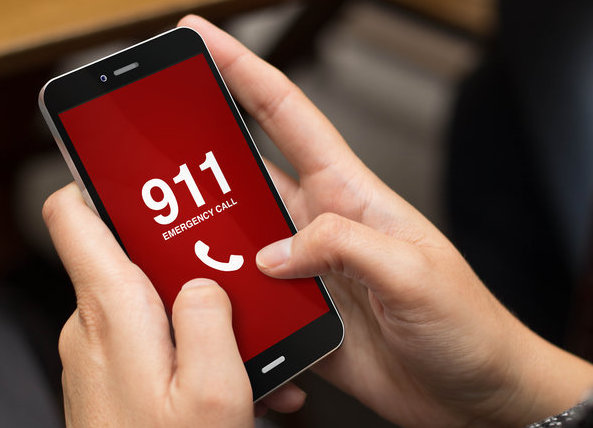|
|
|
| |
| |
|
Substance Use Snapshot Teens, Cannabis and Alcohol - January 2019
|
![Substance Use Snapshot Teens, Cannabis and Alcohol - January 2019]() |
|
|
|
|
|
 | January 2019
Substance Use Snapshot
Teens, Cannabis and Alcohol
|
|
|
|
|

|
ONE
WHAT IS CANNABIS?..................................
Cannabis is a drug that can be produced from plants. The cannabis plant contains many chemicals, including two main active ingredients tetrahydrocannabinol (THC) and
cannabidiol (CBC).
THC affects the brain and produces the high. Over the years, levels of THC have continued to rise. Higher levels can lead to harmful effects.
CBC is currently being studied to determine possible medical benefits.
|
|
|
TWO
WHAT DOES IT LOOK LIKE?........................
Cannabis looks like dried tea leaves usually green or brown. Hashish is made from the plant resin, solid or paste, usually brown or black. A concentrate (aka oil/wax/dabs/shatter) made from the plant is oily, waxy or pasty and usually yellow or brown. |
THREE
WHAT IS IT CALLED?......................................
Pot, weed, chronic, bud, herb, kush, joint, loud, mary jane, mj, blunt, dab, dope, ganja, grass, hash, reefer, skunk, smoke, trees, wax. Synthetic cannaboids can be called spice, K2, Cloud 9, or mojo.
|
|
|

|
FOUR
HOW IS IT USED?..............................................
There is no “safe” amount of cannabis. Using more cannabis increases possibility of harm and addiction. Today's cannabis is much more potent in comparison to the cannabis of previous generations (up to 15x stronger).
Inhaled: Rolled into a joint (cigarette) or blunt (cigar) and smoked; through a bong (water pipe) or in a vaporizer (vape). The effects are immediate and last for hours.
|
|
|
Eaten: Usually added to cookies, muffins, lollipops, gummy candy and brownies (aka edibles). Cannabis tea is also an edible. The effects are delayed by hours and can last up to 12 hours. This can result in eating too much and overdosing or getting really sick.
Symptoms of overdose or “greening out” include: vomiting, psychosis, or panic.
|
|
|
FIVE
WHY DO TEENS USE CANNABIS??.................................................................................................................
After alcohol, cannabis is the most common drug used by Canadian teens. Many people may use cannabis to:
- Get high
- Try something new
- Have fun and relax
- Fit in with peers
- Escape from routine
- Cope or focus
|
|
|

|
SIX
HOW DOES CANNABIS AFFECT THE BRAIN?
The brain is your most important asset. Regular cannabis use can have a negative impact on how your brain grows and develops.
SEVEN
HOW CAN CANNABIS AFFECT TEENS?..........
Although many teens think that regular cannabis use isn’t harmful, the reality is the opposite. Regular cannabis use can cause both short and long-term harm. Cannabis may make you feel relaxed, happy or high. But at the same time it decreases your co-ordination and impairs your judgment, problem solving, memory and learning. It can also cause anxiety, panic and psychosis.
Cannabis CAN be addictive. This is called Cannabis Use Disorder. The earlier a person starts using cannabis and the more cannabis a person uses, the more likely they are to become addicted. Using cannabis with other drugs can increase the risk of harm without giving a better high.
|
|
|
 |
EIGHT
WHAT SHOULD I DO IN AN EMERGENCY?.........................
In case of an emergency call 911 and follow these steps (SJSS):
Safe - bring them to a safe place
Juice - if they aren’t vomiting, give them fruit juice
Side - if they’ve passed out, lie them on their side and wait for the ambulance
Stay - stay with them to provide reassurance and support
|
|
|
|
NINE
HOW CAN I LEARN MORE ABOUT CANNABIS USE?.....................................................................................
It’s important to get the facts about cannabis use. There is a lot of misinformation about cannabis out there. Get informed so that you can TALK SMART. Remember, one of the most common factors for using any drug is peer pressure.
Keep the conversation open with your child and access the shared resources for more information.
TEN
WHERE CAN I FIND MORE INFORMATION?...................................................................................................
Please explore the list of parent resources provided below.
Source: teenmentalhealth.org
|
| |
|
|
|

|
ONE
WHAT IS ALCOHOL?..........................................
Alcohol is the most common psychoactive substance in Canada. It is made from grain, fruit or vegetables that are fermented and then used in beer, wine or liquor (vodka, rum, gin, etc.). Alcohol is also used in other things like mouthwash and hand sanitizer. Some people drink them to try to get intoxicated.
|
|
|
Alcohol is a "downer" or depressant. It slows down the central nervous system and makes a person think, talk and move at a slower pace. The effect alcohol has on a person depends on their size, gender, ethnicity, drinking experience, mood and the environment it is used in. Usually, your body can process about one drink an hour. If you consume more, then you begin to become intoxicated (drunk).
|
|
|
TWO
WHAT ARE THE SHORT TERM EFFECTS OF ALCOHOL?............................................................................
- relaxed
- drowsy
- dizzy
- depressed or aggressive
- problems with coordination and balance
- less able to make thoughtful decisions, poorer judgement
- slower reaction time
- less inhibited (may say or do things you otherwise wouldn't)
- hangover (beginning 8-12 hours after drinking stops) including headache, shakiness
- possible short term memory loss (blackouts)
- alcohol poisoning or overdose is possible
|
|
|

|
THREE
WHAT IS BINGE DRINKING?..........................
Drinking a lot of alcohol in a short time with the intention of getting drunk is called binge drinking. Binge drinking is considered five or more drinks in one sitting for males and four or more drinks in one sitting for females. Binge drinking often leads to a number of physical effects including:
- nausea
- vomiting
- hangover
- shakiness
- blackouts (memory loss)
- passing out
- injury (from having less physical control or from recklessness)
- alcohol poisoning
- health problems, like long-term liver damage
worsening of previously diagnosed health conditions
- possible death
|
|
|

|
FOUR
WHAT ARE THE SYMPTOMS OF ALCOHOL POISONING? ......................................................
- severe confusion
- vomiting
- seizures
- blue colour to skin
- passing out repeatedly
- decrease in body temperature
If a person drinks a lot of alcohol very quickly, it can be fatal. After a person passes out, the alcohol that is in the stomach continues to be absorbed into the bloodstream. If too much alcohol enters the bloodstream, it may cause breathing and heart rate to slow down and eventually stop. Sometimes people who have been drinking vomit in their sleep and then choke to death.
|
|
|
"At our early intervention clinic we recognize the significant potential effects of regular cannabis use on youth and young adult mental outcomes. Engaging youth in an open and non-biased framework of discussion is important in the treatment process. We also recognize the important role that parents can have in this process, thus giving parents the skill set to have these discussions with their kids is vital.ˮ
Dr. Philip Tibbo, Professor of Psychiatry,
Dr. Paul Janssen Chair in Psychotic Disorders, Dalhousie University |
FIVE
WHAT ARE THE LONG TERM EFFECTS OF ALCOHOL?.............................................
- damage to the liver, heart and brain
- diseases of the stomach and pancreas
- cancer of the mouth, throat and esophagus
- high blood pressure
- low red blood cell count (anemia)
- weaker immune system
- muscle weakness
Source: Kelty Mental Health Resource Centre
|
|
|
Below is a very helpful guide “How to Talk to Your Teen”, which can support your efforts in engaging your teen in this conversation.
|
|
|
|
|
PARENT RESOURCES
Book: “Hold onto Your Kids: Why Parents need to Matter More than Peers” Dr. Gordon
Neufeld How to Talk to Your
TeenCannabis Use and Youth: A parent's
guideLet‘s Talk Dialogue Community Conversations about
DrugsParenting: The Drugs
QuestionQuick Guide to Drug
UseLearn about
AlcoholWhat to Look for: Problematic Alcohol
UseHosting a Teen PartyTEACHERS Cannabis: Stories, Questions and Life - this iMinds lesson idea uses Deborah Ellis‘s short story “Through the Woods” (in Lunch with Lenin and Other Stories) as a catalyst for conversation around questions that are useful in examining the impact of cannabis use and regulation on individuals and
relationships. Cannabis and the need for dialogue - this iMinds lesson idea uses Margaret Wheatley's poem, "Turning to One Another," to explore different aspects of dialogue and its significance in the context of shifting policies regarding
cannabis. Free Feeling: Tom Petty, Cannabis and Music as Craft - this iMinds lesson idea uses Tom Petty's song "You Don‘t Know How it Feels" to explore issues like censorship and artistic freedom. And the history of Tom Petty and his long-time band, the Heartbreakers, provides further opportunity to explore the impacts drug use can have on life, work and
relationships. Leaves of the Land: A Quick History of Coca - this iMinds lesson idea explores how drugs and drug use can be linked to social and cultural status and identity. Students are encouraged to reflect on the role of alcohol and other drugs in their community and
culture. The Outsiders - an iMinds teacher's resource for using S. E. Hinton's novel, The Outsiders, to address drug
literacy. Youth Voices on Marijuana - this iMinds instructional outline provides a variety of strategies for engaging students in meaningful conversations about cannabis. The lesson draws on the Blunt Talk report published by the McCreary Society and, in particular, quotes from students taking the Adolescent Health
Survey. CYCLES is an educational resource exploring decision making and marijuana use among young people. Why marijuana use? Because marijuana is a drug with a confusing status: it is widely used by the public, it is sanctioned for the treatment of a number of medical conditions. Although many young people use marijuana, the role of this drug in their day to-day lives is often not addressed by the adults around them or in drug education programs. In order to bridge that gap, a team of researchers at UBC School of Nursing produced a short film, CYCLES, that focuses on high school students‘ decision making around marijuana
use. Drug Literacy
CurriculumQuick Guide to Drug
UseLearn about
AlcoholWhat to Look for: Problematic Alcohol Use
|
|
|
|
|
The Greater Victoria School District is committed to providing safe and healthy learning environments for all students. As part of our approach, we have been focusing on mental health and substance use topics to help us promote well-being in our schools.
Substance use is a complex topic that often highlights varied philosophies, myths, and a great deal of fear. The research shows us that early interventions, particularly around critical thinking and decision making, has an impact on delaying use in youth. As well, open dialogue with adults, intentionality around attachment, and a focus on the
| factors that contribute to substance use, as opposed to the actual substances, also prevent, delay and reduce substance use in our students.
Our goal is to create a more cohesive, systematized substance use plan focusing on social emotional learning, that includes our youth and schools, community partners, and families. We strive for a shared vision, common language and consistent messaging over time, in order to support positive youth culture and a healthy perspective on substance use and mental health.
In B.C. the legal age for alcohol and cannabis consumption is 19 years old.
|
|
|
|
|
| |
|
|
|
|
|
|
|
|
| |
|